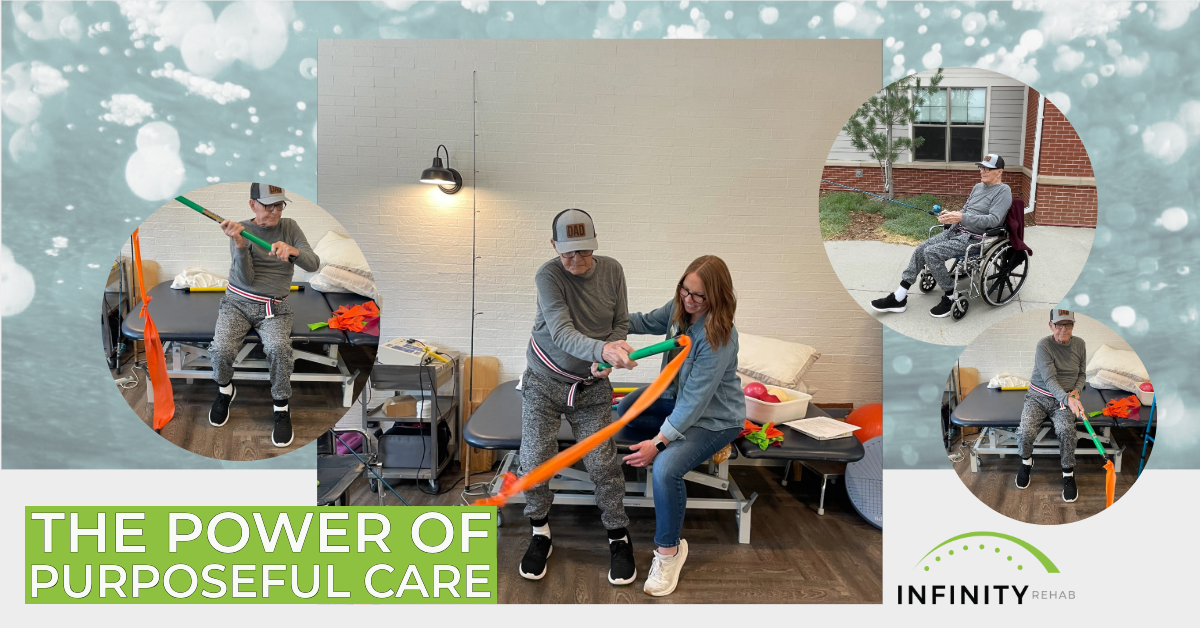Infinity Rehab strives to provide quality care for those we serve. Part of our commitment to quality is educating our patients and their families on what our clinicians do, how treatment can help return to them to independence, and why the services we provide are an integral part of the recovery process after an illness or injury. In celebration of #OTMonth, we’ll focus on the important discipline of occupational therapy.
Occupational therapy helps those suffering from an injury or ailment develop, restore, or maintain occupations – or better understood as activities of daily living (ADLs). ADLs include anything from getting dressed in the morning to cooking dinner to bathing or brushing your teeth – tasks that many people take for granted. For people recovering from an injury, stroke, or living with dementia, relearning or adapting these skills can be an important piece during their rehabilitation journey.
What is the difference between physical therapy and occupational therapy?
This is a common question, as many people believe the two are interchangeable. Physical therapy involves restoring movement, strength, balance, and flexibility. Physical therapists help patients by prescribing exercise, stretching, and more to help them reach physical independence or to recover from an injury. Occupational therapy helps injured or sick patients adapt or re-learn everyday activities. Occupational therapists can adjust tasks or even the tools and environment to help patients reach lifestyle or workplace independence. Simply put, physical therapy will help you walk to the kitchen; occupational therapy will help you cook dinner. Another comparison is physical therapy will help you regain the strength and flexibility to use a wheelchair; occupational therapy will teach you how to use it and prepare your home for a new lifestyle.
As you can probably tell, physical and occupational therapist
s often work hand-in-hand in helping a patient. Both practices have similar goals and outcomes – treating an injury or illness, reaching patient goals, and building or maintaining independence.
Where do occupational therapists work?
At Infinity Rehab, our occupational therapists work in the building you will most likely visit after you’ve recovered enough to leave the hospital. These places include skilled nursing facilities, assisted living communities, and some outpatient clinics. Depending on the situation, occupational therapists may work in home health settings to help patients adjust to their life in the home. This can include participating in everyday activities with the patient and their family, developing tools and equipment to help patients achieve goals and complete tasks, and training individuals on how to build and maintain independence with their condition. Occupational therapists may also work in hospitals, schools, and in the community.
How can occupational therapists help older adults?
We’ve touched on some of the ways occupational therapists can help their patients but there are a variety of treatments at an occupational therapist’s disposal that help with a range of conditions. For example, occupational therapists may help teach a stroke victim to drive again, dress themselves, and prepare meals. If necessary, therapists may develop alternative strategies for patients who have lost the use of a hand or have other disabilities. Some occupational therapists are trained to help patients suffering from dementia or Alzheimer’s. In these cases, developing cognitive function and awareness can be more important than physical ability to complete tasks. The therapist may help the patient share and communicate memories, which can build confidence and security. Most importantly, an occupational therapist will work with family, friends, or caretakers to advise and teach best practices for caring for the patient – and to help promote a healthy relationship.
When would I work with an occupational therapist?
Occupational therapy may take place at any number of times. In some cases, occupational therapy may be used right away after a diagnosis. With dementia or Alzheimer’s, occupational therapy can be a great way to address memory loss, and regain personality and function. Other cases, like stroke or injury from a fall, there may be weeks or months of physical therapy involved before the patient is mobile or healthy enough to start with an occupational therapist. In many situations though, occupational therapy may be concurrent with physical therapy or other treatments to help the patient reach independence as quickly as possible.
Why is occupational therapy important?
Occupational therapy is an important avenue to health and independence that is vital for active aging adults. Occupational therapy helps patients learn how to use regained function in everyday life. It can also help improve cognitive and social skills. Occupational therapists can teach patients how to use equipment like prosthetics or wheelchairs and can help make a safer and more user-friendly home for patients that become disabled temporarily or permanently. Occupational therapy helps patients live their life more efficiently, successfully, and happily.
Thanks for reading and next week we will take a look at the important role of Certified Occupational Therapist Assistants. Happy #OTMonth!






